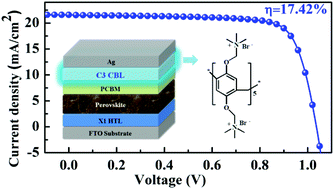Our official English website, www.x-mol.net, welcomes your
feedback! (Note: you will need to create a separate account there.)
A solution-processed pillar[5]arene-based small molecule cathode buffer layer for efficient planar perovskite solar cells†
Nanoscale ( IF 5.8 ) Pub Date : 2018-04-04 00:00:00 , DOI: 10.1039/c8nr00898a Hongwei Lei 1, 2, 3, 4, 5 , Xiaofeng Chen 6, 7, 8, 9, 10 , Lingwei Xue 6, 7, 8, 9, 10 , Linhao Sun 1, 2, 3, 4 , Jianjun Chen 1, 2, 3, 4 , Zuojun Tan 1, 2, 3, 4 , Zhi-Guo Zhang 6, 7, 8, 9, 10 , Yongfang Li 6, 7, 8, 9, 10 , Guojia Fang 4, 5, 11, 12, 13
Nanoscale ( IF 5.8 ) Pub Date : 2018-04-04 00:00:00 , DOI: 10.1039/c8nr00898a Hongwei Lei 1, 2, 3, 4, 5 , Xiaofeng Chen 6, 7, 8, 9, 10 , Lingwei Xue 6, 7, 8, 9, 10 , Linhao Sun 1, 2, 3, 4 , Jianjun Chen 1, 2, 3, 4 , Zuojun Tan 1, 2, 3, 4 , Zhi-Guo Zhang 6, 7, 8, 9, 10 , Yongfang Li 6, 7, 8, 9, 10 , Guojia Fang 4, 5, 11, 12, 13
Affiliation

|
A room-temperature solution-processed pillar[5]arene-based small molecule material, termed C3, has been designed, synthesized, and incorporated between a conventional PCBM electron transport layer (ETL) and a metal electrode to function as a single-layer cathode buffer layer (CBL) for efficient planar p–i–n perovskite solar cells (PVSCs). It has been found that C3 has a work function tunneling effect, which can decrease the work function of the Ag electrode; therefore, introduction of C3 successfully enhances the interface contact and reduces the interface barriers, which usually exist between fullerene derivatives and metal electrodes. It was also found that the C3 capping layer could improve the surface quality of PCBM, forming a smooth, dense and pinhole-free morphology with fewer surface defects. Thus, C3 can modify the interface between PCBM and Ag, enhance the diode properties of devices and facilitate electron transport through the devices; therefore, it is a very promising CBL material for PVSCs. A device with a hybrid PCBM ETL and a single cathode buffer layer of C3 exhibited a high power conversion efficiency (PCE) of 17.42% with negligible hysteresis, which was dramatically higher than that of a device based on a pure PCBM ETL. With the major advantages of a low-temperature solution process and interface modification, the excellent PCE of PVSCs on flexible substrates can exceed 13%. These results demonstrate that solution-processed pillar[5]arene-based small molecule materials can serve as high performance CBLs in PVSCs.
中文翻译:

用于高效平面钙钛矿太阳能电池的固溶柱[5]芳烃基小分子阴极缓冲层†
设计,合成了一种室温固溶处理的基于柱[5]芳烃的小分子材料,称为C3,并结合在传统的PCBM电子传输层(ETL)和金属电极之间以用作单层阴极缓冲层(CBL)用于高效的平面p–i–n钙钛矿太阳能电池(PVSC)。已经发现,C3具有功函数隧穿效应,其可以降低Ag电极的功函数。因此,C3的引入成功地增强了界面接触并减少了通常在富勒烯衍生物和金属电极之间存在的界面壁垒。还发现C3覆盖层可以改善PCBM的表面质量,形成具有较少表面缺陷的光滑,致密和无针孔的形态。因此,C3可以修饰PCBM和Ag之间的界面,增强器件的二极管性能,并促进电子通过器件的传输。因此,它是用于PVSC的非常有前途的CBL材料。具有混合PCBM ETL和C3的单个阴极缓冲层的器件该产品具有17.42%的高功率转换效率(PCE),而滞后作用却可以忽略不计,远高于基于纯PCBM ETL的器件。凭借低温解决方案工艺和界面修改的主要优势,柔性基板上PVSC的出色PCE可以超过13%。这些结果表明,固溶处理的基于柱[5]芳烃的小分子材料可以用作PVSC中的高性能CBL。
更新日期:2018-04-04
中文翻译:

用于高效平面钙钛矿太阳能电池的固溶柱[5]芳烃基小分子阴极缓冲层†
设计,合成了一种室温固溶处理的基于柱[5]芳烃的小分子材料,称为C3,并结合在传统的PCBM电子传输层(ETL)和金属电极之间以用作单层阴极缓冲层(CBL)用于高效的平面p–i–n钙钛矿太阳能电池(PVSC)。已经发现,C3具有功函数隧穿效应,其可以降低Ag电极的功函数。因此,C3的引入成功地增强了界面接触并减少了通常在富勒烯衍生物和金属电极之间存在的界面壁垒。还发现C3覆盖层可以改善PCBM的表面质量,形成具有较少表面缺陷的光滑,致密和无针孔的形态。因此,C3可以修饰PCBM和Ag之间的界面,增强器件的二极管性能,并促进电子通过器件的传输。因此,它是用于PVSC的非常有前途的CBL材料。具有混合PCBM ETL和C3的单个阴极缓冲层的器件该产品具有17.42%的高功率转换效率(PCE),而滞后作用却可以忽略不计,远高于基于纯PCBM ETL的器件。凭借低温解决方案工艺和界面修改的主要优势,柔性基板上PVSC的出色PCE可以超过13%。这些结果表明,固溶处理的基于柱[5]芳烃的小分子材料可以用作PVSC中的高性能CBL。











































 京公网安备 11010802027423号
京公网安备 11010802027423号